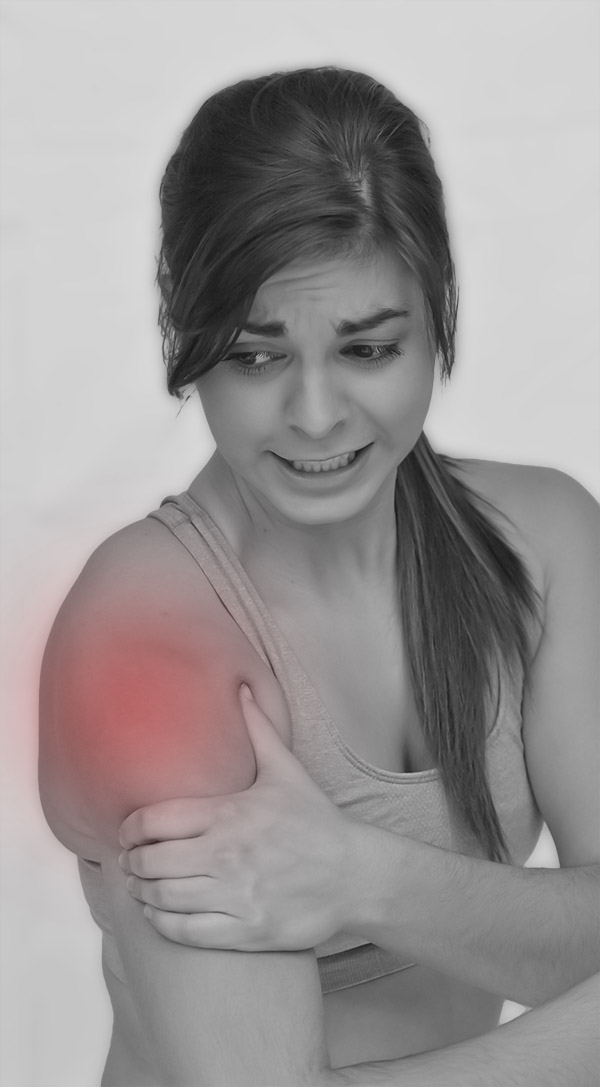 In general terms, shoulder and arm pain can come from two sources. The first to consider would be pain coming down from the neck and landing in either the shoulder or arm. This is known as "Referred or Radicular Pain". The second would be pain generated directly from the shoulder itself as the result of inflammation or injury. Let's explore both.
In general terms, shoulder and arm pain can come from two sources. The first to consider would be pain coming down from the neck and landing in either the shoulder or arm. This is known as "Referred or Radicular Pain". The second would be pain generated directly from the shoulder itself as the result of inflammation or injury. Let's explore both.
Referred Pain - This is pain felt in regions of the shoulder, arm, elbow, hand or fingers that is actually coming from small nerves deeply seated in the various tissues of the neck. For example, injury to a small ligament or muscle deeply seated in the neck can actually refer pain down into the shoulder or arm. Referred pain is a unique phenomenon of the nerve system and by definition is "pain felt in the body at some place other than its actual place of origin" (World English Dictionary).
Radicular Pain - This is pain felt in regions of the shoulder, arm, elbow, hand or fingers that is actually coming from large nerves deeply seated in the region of the neck. Radicular pain from the neck is often called "Radiculopathy or Brachialgia". Both terms refer to pain running down from the neck to the shoulder and arm and as far down as the finger tips. Radicular pain is more complex than referred pain in that it more likely involves a herniated disc or bone spur.
Causes of Referred or Radicular Pain into the Shoulder or Arm
- Spinal Imbalance (Subluxation)
- Disc Degeneration
- Disc Herniation
- Arthritic Degeneration
- Spinal Stenosis
- Muscle Strain
1. Spinal Imbalance (Subluxation)
Misalignment or restricted movement of one or several segments within the neck leads to “Spinal Imbalance” and is a common cause of neck pain. The Chiropractic term for this is “Subluxation”. 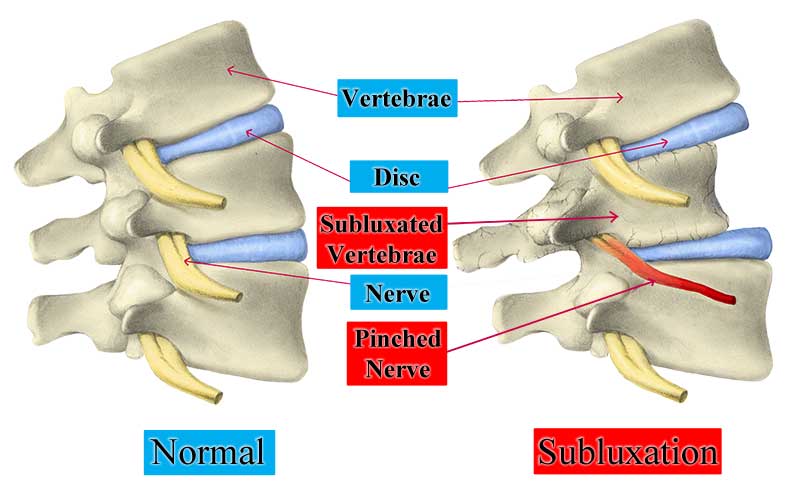 It simply means improper function or alignment within the neck. It would be similar to the front end of your car being out of alignment which leads to a “wobbly” or “shaky” ride. In the neck it leads to irritation of the nerves which in turn causes pain. Spinal imbalance or subluxation in the neck can be a source of referred pain into the shoulder and/or arm. Spinal imbalance can be effectively treated through the use of Chiropractic adjustments thus alleviating the neck pain.
It simply means improper function or alignment within the neck. It would be similar to the front end of your car being out of alignment which leads to a “wobbly” or “shaky” ride. In the neck it leads to irritation of the nerves which in turn causes pain. Spinal imbalance or subluxation in the neck can be a source of referred pain into the shoulder and/or arm. Spinal imbalance can be effectively treated through the use of Chiropractic adjustments thus alleviating the neck pain.
2. Disc Degeneration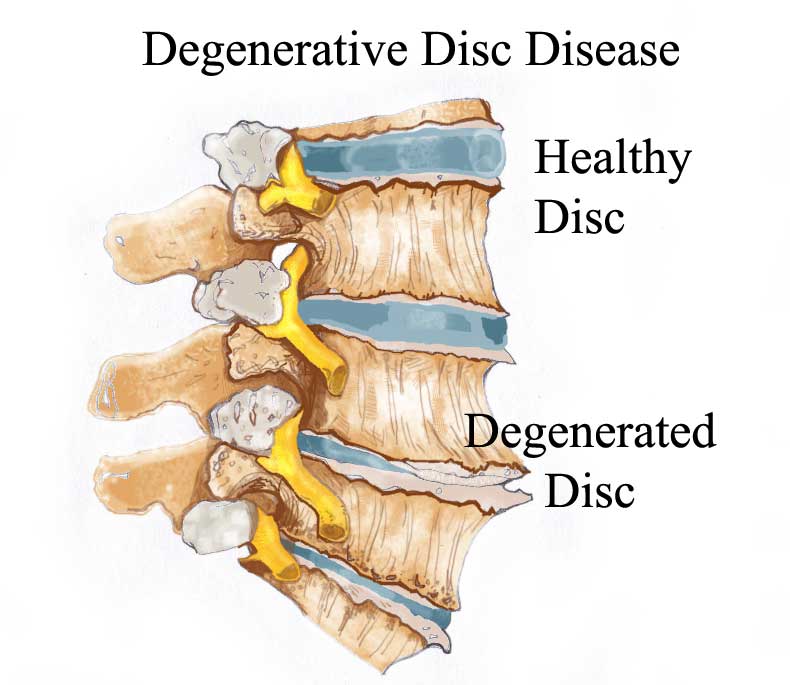
The little cartilage pads that sit between the vertebrae are scientifically known as “vertebral disc’s. Due to either injury or age related wear and tear, these discs can deteriorate. When this occurs the disc begins to flatten and the vertebrae come closer together closing off the openings where the nerves make their exit. This in turn leads to irritation of the nerves which results in pain. Disc degeneration in the neck can be a source of referred or radicular pain into the shoulder and/or arm. Disc degeneration can be helped through a combination of Chiropractic adjustments, Cox Flexion Distraction, physical therapy, nutritional supplementation, exercise and appropriate life style changes.
3. Disc Herniation
Due to injury or strain the little cartilage pads that sit between the vertebrae can get damaged and shift causing them to bulge or herniate and contact the very delicate nerves in the area. This in turn can cause local neck pain or pain that travels all the way down the arm to the hand and fingers. Disc herniation in the neck can be a source of radicular pain into the shoulder and/or arm. Disc injuries can be effectively treated with Cox Flexion Distraction, a form of traction done by the doctor which helps to reduce the pressure inside the disc thus reducing or eliminating the disc bulge. For detailed information on this procedure click on the "Spinal Decompression" link on this web site.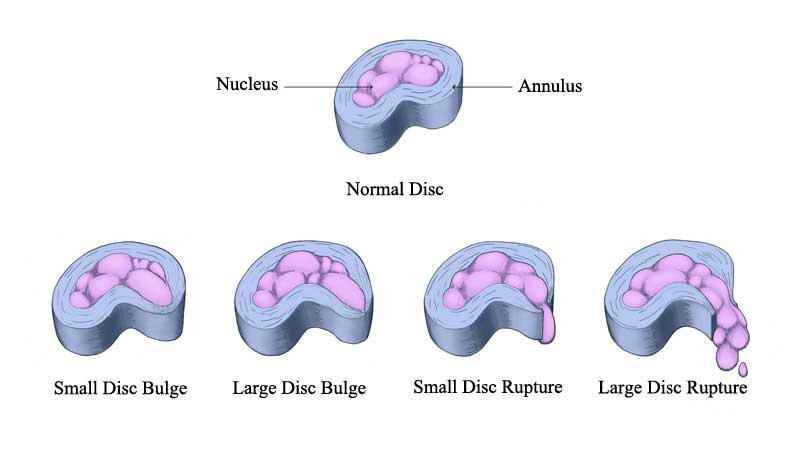
4. Arthritic Degeneration
Due to age related wear and tear or a history of injury, the bony structures around the vertebrae can breakdown and deteriorate which is medically known as Osteoarthritis. This leads to the formation of bone spurs which can contact the delicate nerves in the area causing neck pain. Arthritic degeneration in the neck can be a source of referred or radicular pain into the shoulder and/or arm. Arthritic degeneration can be effectively treated with Cox Flexion Distraction, a form of traction done by the doctor that helps to separate the vertebrae and relieve the pressure on the nerve structures. Along with Chiropractic adjustments, the traction helps to restore movement in the arthritic areas making it less likely that the spurs will come into contact with the nerves. A good "joint formula" nutritional supplement can also be helpful in the successful treatment of arthritic degeneration of the spine.
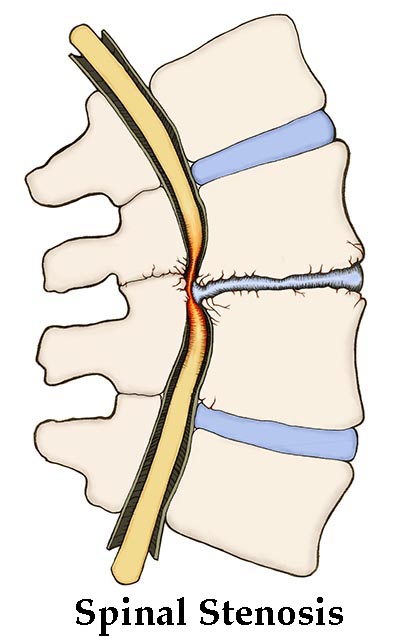 5. Spinal Stenosis
5. Spinal Stenosis
Spinal stenosis is the narrowing of the spaces or openings in the spine resulting in compression of the spinal cord or nerve roots. It is the long term result of spinal degeneration or arthritis and is typically associated with disc degeneration and significant loss of disc height. It is primarily a condition of the elderly. Spinal stenosis in the neck can be a source of referred or radicular pain into the shoulder and/or arm. When treated properly it can respond favorably to Chiropractic care. One study showed that lumbar spinal stenosis patients improved by 76% and disability improved by 73% in 57 patients treated with "Cox Flexion Distraction" which is a method used in this office. Dr. Garber teaches "Cox Flexion Distraction" as an upper quarter elective to the students at Life University in Marietta Georgia.
6. Muscle or Ligament Strain or Sprain
Due to overuse as in weekend 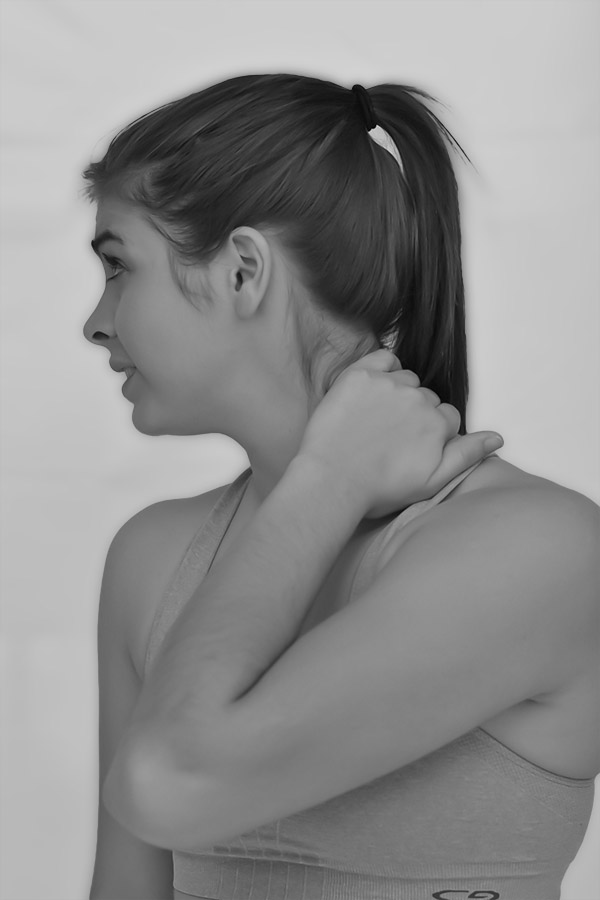 sports or gardening or an event like a car accident, the muscles around the neck can be subject to more strain than they can handle thus injuring some of the muscle fibers. Medically this is known as muscle strain. Muscle strain leads to inflammation which in turn leads to neck pain. Muscle strain/sprain in the neck can be a source of referred pain into the shoulder and/or arm. Through the use of Chiropractic adjustments, massage, physical therapy, exercise and appropriate lifestyle changes, muscle strain can be effectively treated and resolved thus eliminating the neck pain.
sports or gardening or an event like a car accident, the muscles around the neck can be subject to more strain than they can handle thus injuring some of the muscle fibers. Medically this is known as muscle strain. Muscle strain leads to inflammation which in turn leads to neck pain. Muscle strain/sprain in the neck can be a source of referred pain into the shoulder and/or arm. Through the use of Chiropractic adjustments, massage, physical therapy, exercise and appropriate lifestyle changes, muscle strain can be effectively treated and resolved thus eliminating the neck pain.
Shoulder Pain From Direct Injury Or Inflammation
The shoulder is a ball and socket joint with a large range of movement. It also has four major muscle attached to it that control all of its movement. These four muscles combined are known as the "Rotator Cuff". Such a mobile joint tends to be susceptible to injury. Pain in the shoulder is a common complaint, and there are many common causes of this problem. It is important to make an accurate diagnosis of the cause of your symptoms so that appropriate treatment can be directed at the cause. There are numerous types of painful shoulder conditions such as dislocation, separation, labral tear, SLAP lesion, biceps tendon rupture, ligament sprains, calcific tendonitis, and several others. Some common causes of shoulder pain seen in a Chiropractic office include:
- Shoulder Bursitis or Rotator Cuff Tendonitis
- Frozen Shoulder
- Shoulder Joint Instability
- Shoulder Arthritis
Lets briefly explore a few of the different causes of shoulder pain:
Shoulder Bursitis or Rotator Cuff Tendonitis
(impingement syndrome)
Any term ending in "itis" always indicates that inflammation is present. Simply put, bursitis is inflammation of a bursa or protective pad and tendinitis is inflammation of a tendon or the structure that holds a muscle to a bone.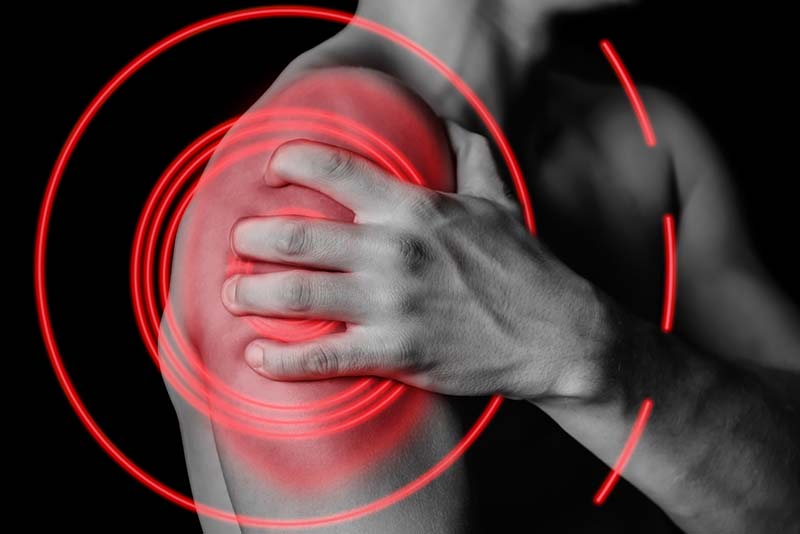
Another term used to describe this is "impingement syndrome". Impingement syndrome occurs when there is inflammation of the rotator cuff tendons and the bursa that surrounds these tendons. Impingement simply means that something is getting pinched and that is exactly what is happening in this case. Due to the inflammation and swelling of these structure, when you move your shoulder in certain directions the bursa and/or the tendons get pinched....this leads to PAIN! Although bursitis and rotator cuff tendonitis are separate conditions, they often occur simultaneously. Through a combination of Chiropractic adjustments to the spine and the shoulder, combined with electrical muscle stimulation (physical therapy), exercise, nutritional supplementation, and life style changes these type shoulder problems can be nicely resolved.
Frozen Shoulder (Adhesive Capsulitis)
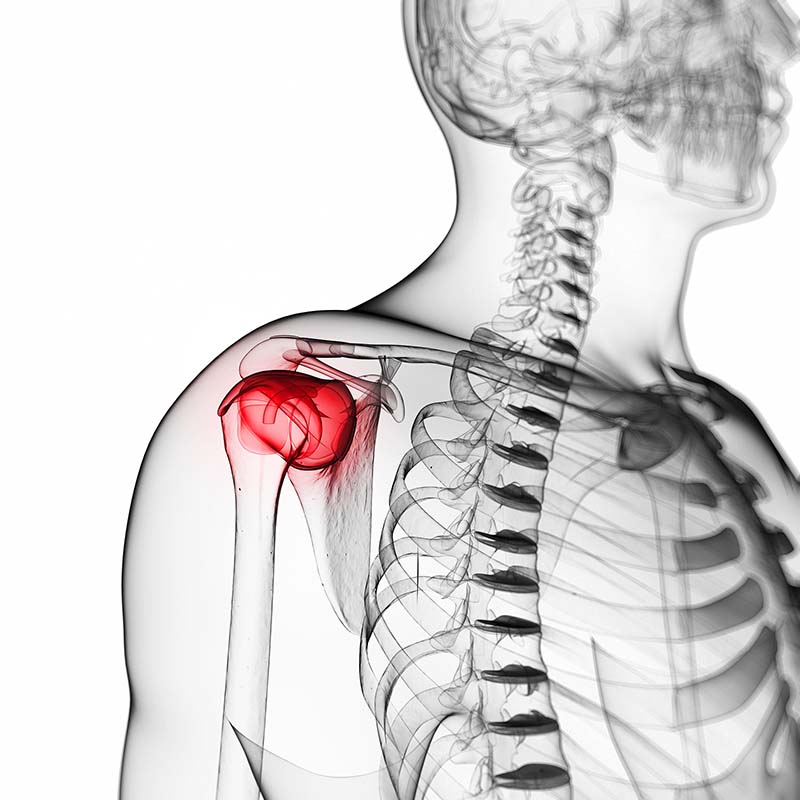 Frozen shoulder, or adhesive capsulitis, is a condition that causes painful and restricted movement of the shoulder. The cause of a frozen shoulder is not well understood, but it often occurs after some form of trauma or for no known reason at all. Frozen shoulder causes the capsule surrounding the shoulder joint to contract and form scar tissue. The scar tissue surrounding the shoulder causes the joint to become very stiff and especially painful to raise out to the side of the body. Frozen shoulder most commonly affects patients between the ages of 40 to 60 years old, and it is twice as common in women than in men. Patients with diabetes are at particular risk for developing a frozen shoulder. Through a combination of Chiropractic adjustments to the spine and the shoulder, combined with physical therapy, exercise, nutritional supplementation, and life style changes these type shoulder problems can be resolved.
Frozen shoulder, or adhesive capsulitis, is a condition that causes painful and restricted movement of the shoulder. The cause of a frozen shoulder is not well understood, but it often occurs after some form of trauma or for no known reason at all. Frozen shoulder causes the capsule surrounding the shoulder joint to contract and form scar tissue. The scar tissue surrounding the shoulder causes the joint to become very stiff and especially painful to raise out to the side of the body. Frozen shoulder most commonly affects patients between the ages of 40 to 60 years old, and it is twice as common in women than in men. Patients with diabetes are at particular risk for developing a frozen shoulder. Through a combination of Chiropractic adjustments to the spine and the shoulder, combined with physical therapy, exercise, nutritional supplementation, and life style changes these type shoulder problems can be resolved.
Shoulder Joint Instability
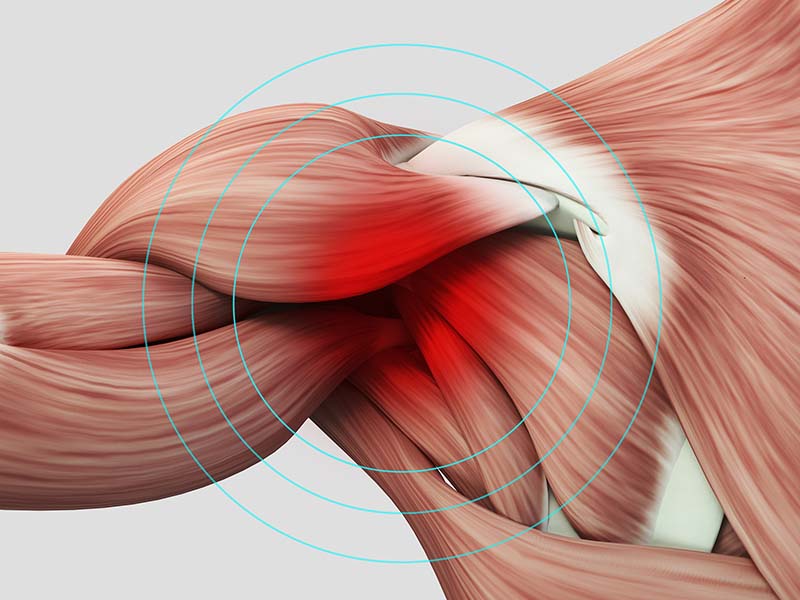 Shoulder instability occurs when the structures that hold the shoulder joint in place do not work properly to maintain the ball within its socket. If the joint is too loose, is may partially slide or slip out of place, a condition called shoulder subluxation. If the joint comes completely out of place, this is called a shoulder dislocation. Patients with shoulder instability often complain of a feeling that their shoulder is about to slide out of place--which is labeled as "apprehension". Shoulder dislocation tends to occur in individuals who have had a prior traumatic dislocation due to weakened and damaged muscles and ligaments, in young athletes who don't have fully developed muscles and ligaments, and in "Double-Jointed" individuals who have naturally loose joints. Through a combination of Chiropractic adjustments to the spine and the shoulder, combined with physical therapy, specific shoulder stabilization exercises, nutritional supplementation, and life style changes these type shoulder problems can be helped.
Shoulder instability occurs when the structures that hold the shoulder joint in place do not work properly to maintain the ball within its socket. If the joint is too loose, is may partially slide or slip out of place, a condition called shoulder subluxation. If the joint comes completely out of place, this is called a shoulder dislocation. Patients with shoulder instability often complain of a feeling that their shoulder is about to slide out of place--which is labeled as "apprehension". Shoulder dislocation tends to occur in individuals who have had a prior traumatic dislocation due to weakened and damaged muscles and ligaments, in young athletes who don't have fully developed muscles and ligaments, and in "Double-Jointed" individuals who have naturally loose joints. Through a combination of Chiropractic adjustments to the spine and the shoulder, combined with physical therapy, specific shoulder stabilization exercises, nutritional supplementation, and life style changes these type shoulder problems can be helped.
Shoulder Arthritis
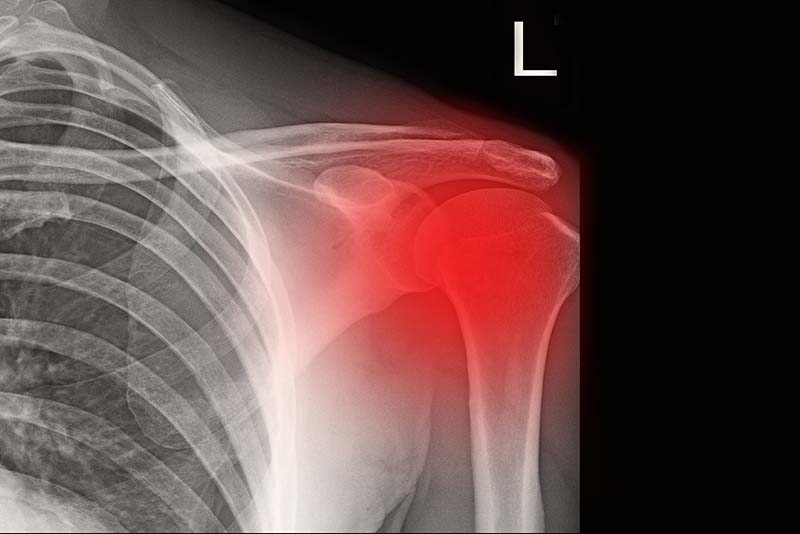 Osteoarthritis or "wear and tear" arthritis is the most common type of arthritis that affects the shoulder. Also called degenerative joint disease (DJD), osteoarthritis is characterized by a slow but progressive wearing away of the cartilage within a joint. As the protective cartilage surface of the joint is worn away by shoulder arthritis, bare bone can be exposed within the shoulder. Arthritis of the shoulder typically begins to affect individuals in the 5th decade of life and becomes increasingly evident in individuals with a history of prior shoulder injury such as football players or heavy construction workers. This is one type of arthritis that patients state is affected by the weather making the patient a more accurate meteorologist than the ones on TV. Some of the more common symptoms associated with shoulder arthritis are:
Osteoarthritis or "wear and tear" arthritis is the most common type of arthritis that affects the shoulder. Also called degenerative joint disease (DJD), osteoarthritis is characterized by a slow but progressive wearing away of the cartilage within a joint. As the protective cartilage surface of the joint is worn away by shoulder arthritis, bare bone can be exposed within the shoulder. Arthritis of the shoulder typically begins to affect individuals in the 5th decade of life and becomes increasingly evident in individuals with a history of prior shoulder injury such as football players or heavy construction workers. This is one type of arthritis that patients state is affected by the weather making the patient a more accurate meteorologist than the ones on TV. Some of the more common symptoms associated with shoulder arthritis are:
- Pain with certain movements
- Stiffness of the shoulder
- Swelling of the joint
- Tenderness when touched
- A feeling of grinding or crackling within the joint
Through a combination of Chiropractic adjustments to the spine and the shoulder, combined with physical therapy, specific shoulder exercises, nutritional supplementation, and life style changes these type shoulder problems can be helped.
Natural nutritional supplements such as Glucosamine and Chondroitin Sulfate appear to be effective in certain individuals for treatment of shoulder arthritis. Many patients find moderate but significant relief with these products for symptoms of shoulder arthritis.
Paresthesia
(Pins and Needles)
Paresthesia is a diagnostic term that refers to a feeling of tingling, prickling, numbness or burning usually felt in the arms or hands. Most of you have experienced temporary paresthesia or "pins and needles" by falling asleep on your arm or hand while it was sandwiched under your head. When you woke up your arm or hand was asleep and tingling and so you got up and shook it out.
What is the cause of Paresthesia (Pins and Needles)
Temporary paresthesia is caused when too much pressure is placed upon blood vessels that supply oxygen and nutrients to a nerve for too long a period of time, irritating the nerve or disrupting its function. Once pressure is removed from the blood vessels and the blood begins to flow, the nerve "wakes up" or begins to properly function again and the condition goes away within a few minutes.
Chronic paresthesia is more complicated and is due to a variety of neurological conditions. Disorders such as strokes or TIA's (Transient Ischemic Attacks - Mini Strokes) can cause ongoing paresthesia in the arms or legs. Carpal tunnel syndrome, tarsal tunnel syndrome and other nerve entrapment syndromes can also be the root cause behind paresthesia or "pins and needles" in the arm or legs. Serious conditions such as multiple sclerosis or brain tumors and aneurisms can also be a root cause behind paresthesia.
In our office, the most common cause for paresthesia is the subluxated or misaligned vertebrae. When a vertebrae misaligns, it puts too much pressure on the exiting nerves causing pain or sometimes just causing numbness and tingling which is medically known as paresthesia. The good news is that subluxations can be corrected or reduced often times eliminating or minimizing the paresthesia as pressure is relieved off of the involved nerves.
For more information on Paresthesia or Pins and Needles visit the two websites below:
http://en.wikipedia.org/wiki/Paresthesia
http://www.ninds.nih.gov/disorders/paresthesia/paresthesia.htm
If you, or a loved one, are experiencing pain contact our office to schedule a free NO obligation consultation with the doctor or email Dr. Garber with a question concerning your case for a quick response. Garber Chiropractic Care Center 770-386-7707
Chiropractic Care and Pain Relief for Cartersville, Acworth, Taylorsville, White and Euharlee GA.
